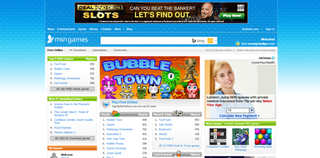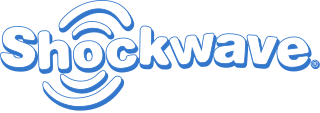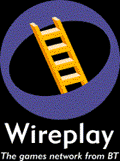
AOL is an American web portal and online service provider based in New York City, and a brand marketed by Yahoo! Inc.

Quake III Arena is a 1999 multiplayer-focused first-person shooter developed by id Software. The third installment of the Quake series, Arena differs from previous games by excluding a story-based single-player mode and focusing primarily on multiplayer gameplay. The single-player mode is played against computer-controlled bots. It features music composed by Sonic Mayhem and Front Line Assembly founder Bill Leeb.

The term chat room, or chatroom, is primarily used to describe any form of synchronous conferencing, occasionally even asynchronous conferencing. The term can thus mean any technology, ranging from real-time online chat and online interaction with strangers to fully immersive graphical social environments.

Prodigy Communications Corporation was an online service from 1984 to 2001 that offered its subscribers access to a broad range of networked services. It was one of the major internet service providers of the 1990s.
Tencent QQ, also known as QQ, is an instant messaging software service and web portal developed by the Chinese technology company Tencent. QQ offers services that provide online social games, music, shopping, microblogging, movies, and group and voice chat software. As of March 2023, there were 597 million monthly active QQ accounts.

GameSpy was an American provider of online multiplayer and matchmaking middleware for video games founded in 1999 by Mark Surfas. After the release of a multiplayer server browser for Quake, QSpy, Surfas licensed the software under the GameSpy brand to other video game publishers through a newly established company, GameSpy Industries, which also incorporated his Planet Network of video game news and information websites, and GameSpy.com.

GameSpy Arcade was a shareware multiplayer game server browsing utility. GameSpy Arcade allowed players to view and connect to available multiplayer games, and chat with other users of the service. It was initially released by GameSpy Industries, on November 13, 2000, to replace the aging GameSpy3D and Mplayer.com program. Version 2.0.5 was the latest offering of the software, boasting additional features such as increased speed and advanced server sorting abilities.

Pogo.com is a free online gaming website that offers over 50 casual games from brands like Hasbro and PopCap Games. It offers a variety of card and board games to puzzle, sports and word games. It is owned by Electronic Arts and is based in Redwood Shores, California.

Xfire was a proprietary freeware instant messaging service for gamers that also served as a game server browser with various other features. It was available for Microsoft Windows. Xfire was originally developed by Ultimate Arena based in Menlo Park, California.
XBAND was one of the first competitive online console gaming networks and was available for the Genesis and Super NES. It was produced by Catapult Entertainment in Cupertino, California. It is the only modem released in America to have been officially licensed by Nintendo. It debuted in various areas of the United States between November 1994 and June 1995 and was later released nationwide between October 2 and 8, 1995.

Roger Wilco is one of the first voice-over-IP client programs designed primarily for use with online multiplayer video games. Roger Wilco enabled online gamers to talk to one another through a computer headset or other audio input device instead of typing messages to each other. Within a year of the software's introduction, over 2 million online video gamers were using the application.

Paltalk is a proprietary video group chat service that enables users to communicate by video, Internet chat, or voice. It offers chat rooms and the ability for users to create their own public virtual chat room. Paltalk Desktop is available on macOS and Windows, and Paltalk Video Chat App is available for Android and iOS. While basic services are free of charge and basic software is free to download, fee-based memberships and paid upgrades to more capable versions are offered by AVM Software, the creators of Paltalk.

MSN Games is a casual gaming web site, with single player, multiplayer, PC download, and social casino video games. Games are available in free online, trial, and full feature pay-to-play versions.
SegaSoft, originally headquartered in Redwood City, California and later San Francisco, was a joint venture by Sega and CSK, created in 1995 to develop and publish games for the PC and Sega Saturn, primarily in the North American market.

The Dial-up Wide-Area Network Game Operation, better known by the acronym DWANGO, was an early online gaming service based in the United States. Launched in 1994, it was originally known for its compatibility with Doom, for which it functioned as a matchmaking service for online multiplayer. The service also supported various other titles, including other id Software games such as Doom II and Heretic as well as titles from other companies like Duke Nukem 3D, Blood, and Shadow Warrior from 3D Realms.

NeoPlanet was a Trident-shell graphical web browser initially released in 1997 by New York–based Bigfoot International, Inc. and later maintained and developed by its subsidiary NeoPlanet, Inc. It was one of the first browsers to be fully skinnable.

Shockwave.com, or Shockwave, is an online and offline video games distributor and game portal. It is owned by Shockwave LLC, based in Los Angeles, California, United States. It was launched by Macromedia on August 2, 1999, to promote the company's Shockwave and Flash players, both used on the website. As of 2005, the website had 22 million users. By 2010, it hosted more than 400 games in a variety of genres.
Online console gaming involves connecting a console to a network over the Internet for services. Through this connection, it provides users the ability to play games with other users online, in addition to other online services.
Based on id Software's open stance towards game modifications, their Quake series became a popular subject for player mods beginning with Quake in 1996. Spurred by user-created hacked content on their previous games and the company's desire to encourage the hacker ethic, Id included dedicated modification tools into Quake, including the QuakeC programming language and a level editor. As a game that popularized online first-person shooter multiplayer, early games were team- and strategy-based and led to prominent mods like Team Fortress, whose developers were later hired by Valve to create a dedicated version for the company. Id's openness and modding tools led to a "Quake movie" community, which altered gameplay data to add camera angles in post-production, a practice that became known as machinima.

Wireplay was an online multiplayer gaming network available as a dial-up service that allowed players to match up and play PC games with each other remotely. Compatible games had Wireplay capability built into the game itself, with the online service being launched from the game's menu. The service was created by BT Group and was released to the public in the UK in June 1996. 18 months later, BT licensed the technology to telephone companies in Australia and the US. At its peak, there were more than 100,000 registered users and 50,000 active monthly users in the UK. It was sold to Gameplay plc. for £5.5 million in 2000, but following the sale, the service began to make losses and in August 2001 it was reduced to a shell company and was looking to sell off Wireplay. Arena Technik then bought the service on 31 August 2001. The service endured for a time but was finally shut down in 2014.
















